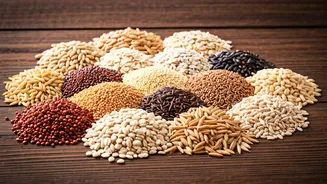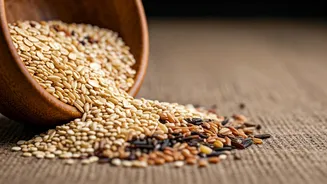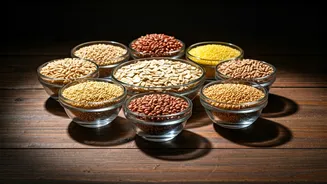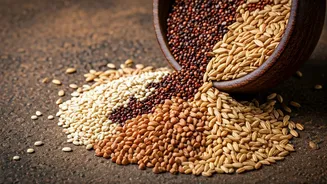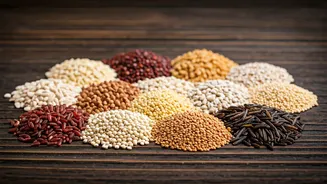Introduction to Grains
Grains are a staple food source in India, offering essential nutrients, including fiber, vitamins, and minerals. However, not all grains are created equal
when it comes to their impact on blood sugar. Selecting the right grains can make a huge difference for people with diabetes. These grains are digested at a slower rate, leading to a gradual release of glucose into the bloodstream, which is important to avoid sudden spikes. Additionally, these grains can also improve insulin sensitivity, contributing to overall health. It's a great approach for individuals with diabetes or those looking to improve their health. The key is to select grains that provide sustained energy and minimize any detrimental impacts on blood glucose levels.
Embracing Barley
Barley is a grain that is a good source of soluble fiber, which helps slow down the absorption of sugar and improves insulin sensitivity. Barley offers a rich texture and a slightly nutty flavor, making it a versatile ingredient. You can use it in soups, stews, or salads. Barley also has a lower glycemic index (GI) compared to many other grains, preventing significant blood sugar spikes. Incorporating barley into your diet can be a delicious and beneficial way to manage blood sugar. It's also known to reduce cholesterol levels, which provides additional health benefits. It is a grain worth exploring for its wide-ranging nutritional benefits and its role in controlling blood sugar.
Oats and Diabetes
Oats are well-recognized for their ability to help manage diabetes due to their high fiber content, particularly soluble fiber, which aids in delaying sugar absorption. Oats have a low GI and provide sustained energy release, making them an excellent breakfast choice. They can be prepared in various ways, such as oatmeal, overnight oats, or used in baked goods. Oats also contain beta-glucan, a type of soluble fiber, which helps regulate blood sugar levels and improve cholesterol levels. Eating oats daily will help improve blood sugar control. They are a simple and delicious addition to any diabetes-friendly diet. Make sure that you select the less processed varieties for optimal benefits.
The Power of Quinoa
Quinoa is a seed, commonly used as a grain, that is a complete protein source, containing all nine essential amino acids. It's also high in fiber, aiding in blood sugar management. Quinoa has a low GI and is rich in nutrients like magnesium, which can improve insulin sensitivity. It can be a great substitute for rice and other grains, offering a versatile base for salads, sides, and main courses. The high fiber content in quinoa supports digestive health and aids in preventing blood sugar spikes. Quinoa is a great choice because of its nutritional profile and its effect on blood sugar levels. It helps you stay full and aids in maintaining stable blood glucose levels.
Ragi's Advantages
Ragi, also known as finger millet, is a staple in many Indian diets and is rich in fiber and has a low GI. It helps in slowing down glucose absorption, which is beneficial for blood sugar control. Ragi is also a good source of calcium and iron, making it a nutritious choice for overall health. It can be used to prepare rotis, dosas, and porridge. It is an excellent choice for individuals with diabetes, thanks to its high fiber content and its ability to prevent rapid blood sugar level increases. It offers a variety of nutrients and is a tasty and versatile grain to add to your diet. It also has good amounts of polyphenols that can help reduce oxidative stress and inflammation.
Brown Rice Benefits
Brown rice is a whole grain that retains its bran and germ, which are rich in fiber, vitamins, and minerals. Compared to white rice, brown rice has a lower GI and results in a slower release of glucose into the bloodstream. It provides sustained energy and supports better blood sugar control. Brown rice is a good source of magnesium, which plays a role in insulin sensitivity. You can use brown rice in place of white rice. The fiber content in brown rice slows down digestion. It is a healthy alternative that helps you manage blood sugar levels and offers essential nutrients. It is a versatile grain and a good base for various meals.
Jowar for Blood Sugar
Jowar, also known as sorghum, is another beneficial grain for people with diabetes, thanks to its high fiber content and low GI. It is a staple grain in many parts of India and can be used to make rotis and other dishes. Jowar helps to slow down the absorption of glucose, preventing significant spikes in blood sugar levels. It also provides essential nutrients like iron and is gluten-free, making it suitable for those with gluten sensitivities. This grain will help to keep blood sugar levels steady and promotes overall health. Jowar is a good option. It is a traditional grain with modern health benefits.
Bajra's Role in Diet
Bajra, or pearl millet, is a gluten-free grain that is commonly consumed in India and is rich in fiber and has a low GI, making it a good choice for people with diabetes. It aids in slowing down glucose absorption, helping to regulate blood sugar levels. Bajra is also a good source of iron and magnesium. It is frequently used to make rotis and porridges. It offers sustained energy release and helps improve insulin sensitivity, supporting better blood sugar control. Incorporating bajra into your meals adds nutritional value and helps in managing blood glucose levels effectively. This grain is a staple that supports a healthy diet, particularly for people with diabetes.
Amaranth for Health
Amaranth is a pseudo-grain that is high in protein and fiber, making it a valuable addition to a diabetes-friendly diet. It is also a good source of minerals. It offers a low GI, which helps in preventing blood sugar spikes and aids in maintaining stable blood sugar levels. Amaranth can be used in various ways, such as in porridges, salads, and as a flour substitute in baking. It provides a unique nutritional profile, including lysine, an amino acid that is often lacking in other grains. It is a gluten-free option. Amaranth is an excellent addition to your diet for people with diabetes, offering both nutrition and support in blood sugar control.
Buckwheat's Contribution
Buckwheat, although not a grain but a seed, has a low GI and is rich in fiber, making it a helpful choice for managing blood sugar levels. It also provides a variety of essential nutrients. Buckwheat helps to slow down the digestion and absorption of glucose, which prevents sudden spikes. Buckwheat is a versatile ingredient that can be used to make pancakes, noodles, and other dishes. It contains rutin, an antioxidant that has anti-inflammatory properties and can enhance insulin sensitivity. Buckwheat provides a good balance of nutrients and helps people with diabetes maintain steady blood sugar levels. It's an excellent choice for those seeking to diversify their diet while promoting their health.





